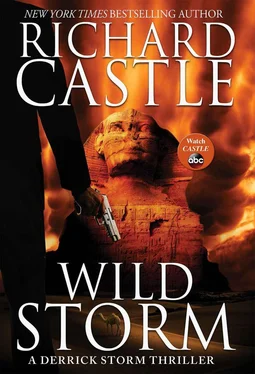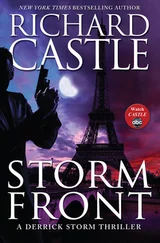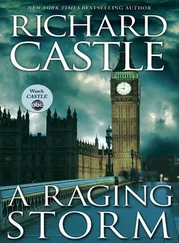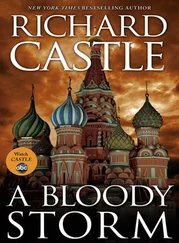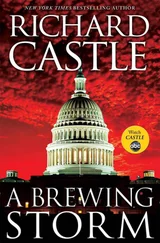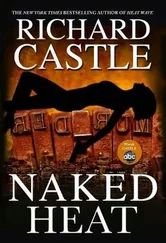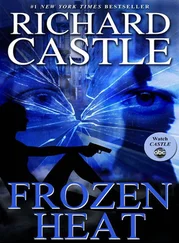Richard Castle - Wild Storm
Здесь есть возможность читать онлайн «Richard Castle - Wild Storm» весь текст электронной книги совершенно бесплатно (целиком полную версию без сокращений). В некоторых случаях можно слушать аудио, скачать через торрент в формате fb2 и присутствует краткое содержание. Год выпуска: 2014, ISBN: 2014, Издательство: Kingswell, Жанр: Криминальный детектив, на английском языке. Описание произведения, (предисловие) а так же отзывы посетителей доступны на портале библиотеки ЛибКат.
- Название:Wild Storm
- Автор:
- Издательство:Kingswell
- Жанр:
- Год:2014
- ISBN:9781484711422
- Рейтинг книги:3 / 5. Голосов: 1
-
Избранное:Добавить в избранное
- Отзывы:
-
Ваша оценка:
- 60
- 1
- 2
- 3
- 4
- 5
Wild Storm: краткое содержание, описание и аннотация
Предлагаем к чтению аннотацию, описание, краткое содержание или предисловие (зависит от того, что написал сам автор книги «Wild Storm»). Если вы не нашли необходимую информацию о книге — напишите в комментариях, мы постараемся отыскать её.
Wild Storm — читать онлайн бесплатно полную книгу (весь текст) целиком
Ниже представлен текст книги, разбитый по страницам. Система сохранения места последней прочитанной страницы, позволяет с удобством читать онлайн бесплатно книгу «Wild Storm», без необходимости каждый раз заново искать на чём Вы остановились. Поставьте закладку, и сможете в любой момент перейти на страницу, на которой закончили чтение.
Интервал:
Закладка:
With that, he was on the move again, back to the coach section, toward the emergency exit rows. In this part of the plane, real terror had set in among the passengers. They had seen the wing. They felt the plane’s bank. Some were sobbing. Some had grabbed on to loved ones. Others were praying.
“I’m going to need you folks to clear out of here,” he said to the people seated in the exit rows. “There’s much less chance of your being sucked out of the airplane if you do.”
Those words — sucked out of the airplane — and the image they produced — had an immediate effect. The four seats, two in each row, emptied as the man from seat 2B stepped into his harness and attached one of his ropes to the front of it. He took the other end, looped it several times around seat 20B, and tied the sturdiest knot he knew.
He yanked hard to test it. The man from seat 2B could bench press 330 pounds and squat at least twice as much. He knew those numbers were nothing compared to the forces that might soon be exerted on this rope. He just had to hope it would hold.
Clamping the roll of speed tape in his teeth, he removed the seal from the emergency door, grasped it in both hands, and threw it out of the plane. He ignored the screams from several nearby passengers and concentrated on his next task.
As a kid, the man from seat 2B had enjoyed rolling down the window of his father’s Buick — always a Buick — and cupping his hand against the wind that rushed at him, pushing at it in a test of his young strength. At 60 miles an hour, it was a struggle. The plane was moving more than twice as fast — 140 knots is equal to 160 miles an hour. But he wasn’t a kid anymore. He flattened himself against the floor, took one deep breath.
And then he began to crawl onto the surface of the wing.
He was pointed forward, toward the plane’s nose, keeping one foot braced against the side of the porthole. The wind tore at him, doing its best to pry him loose. Only by keeping his profile flat could he keep himself from being swept away. The rope that tethered him to the plane might or might not hold his weight if called upon. The man from seat 2B was not especially keen to find out.
His objective, as he continued creeping ahead, was to reach the leading edge of the wing. He worked his way there slowly, with hands made strong and calloused by weeks in the mountains.
When he reached the edge he grasped it, then began inching away from the body of the plane, toward the tip of the wing. He slid one hand, then the other, not daring to move too quickly, until he reached the section of the wing where he could hear the aileron flapping behind him.
Now came the first hard part: getting himself turned around.
As if he was doing a pull-up, he yanked himself toward the leading edge of the wing. Then he hooked his right arm around it, followed by his right leg. The force of the wind was now keeping at least part of him pinned to the plane. Trying not to think about how much of his body was dangling fourteen thousand feet above southern Pennsylvania farmland, he reached his left hand out behind him. He followed it with his right hand until he was facing behind the plane. He wriggled toward the back edge of the wing.
Now the second hard part: grabbing the aileron.
The sheet of metal was a moving target, and there was no way he could reach it anyway — not without losing what little purchase he had on the wing. He grasped, instead, for the narrow strip of metal that had kept the aileron from flying away. Once he had it in his right hand, he began pulling it toward himself — right hand, left hand, right hand, left — until he had it.
He was thankful for the rubberized toes of his hiking boots. He doubted loafers would have had enough grip to keep him on the wing, especially as it continued its inexorable downward tilt. The death spiral was setting in. If the wing got much more pitch to it, his job was going to become impossible.
With the aileron finally in his hands, he moved on to the third hard part: securing it back in place.
Trapping the aileron under his body, he peeled a length of speed tape. While it looked like duct tape, speed tape was made from aluminum. It first came into heavy use during the Vietnam War, when it was used in the field to temporarily fix helicopters that had been damaged by small arms fire. In air force slang, it was called Thousand-MPH tape.
The man from seat 2B hoped the name wasn’t overselling the tape’s abilities as he attached the first strip of it to the sheet metal of the aileron. Then another strip. Then another. It was heavy tape, and it had a heavy job to do. When he felt he had used enough, he moved the aileron into what he judged was close to its original position. Or at least close enough. He pressed it down, keeping it there with his wrists as he unspooled more tape with his hands. He added several more pieces until he had something like confidence in his jury-rigging.
Then came the critical moment, the one when he needed to take his hands off the aileron. If it didn’t stay in place, he might as well just jump off the plane. There wouldn’t be time to repeat what he had just done before the death spiral took them down. This was the moment of truth for him and every other man, woman, and child aboard.
He let go.
The aileron held.
AS THEY MADE THEIR FINAL APPROACH to Dulles airport, a phalanx of fire trucks and ambulances were lining the runway. Battling valiantly, with at least some control returned to him, Captain Estes had willed the plane to limp through the final hundred miles of its journey. It was later opined that only one of America’s finest pilots could have pulled off what he had done. He was destined for a Time magazine cover, a book deal, even a guest appearance on a highly rated ABC television crime drama.
The man who made it possible had returned to seat 2B, as if nothing at all had happened, as if he were just another passenger. Even when his fellow travelers tried to thank him, he just shook his head, gestured toward the cockpit, and said, “I’m not the one who landed this thing.” The plane touched down to the sound of boisterous cheering. When Peggy the flight attendant — who was already planning her own special thank you to Captain Estes — came on the public-address system and said, “Welcome to Dulles airport,” the passengers burst into applause again.
The man in seat 2B felt hands pounding his back. He experienced no special euphoria, no thrill of being alive, only dread. The other passengers did not know about the larger tragedy that was unfolding outside the plane’s doors. They were unaware that whereas they had escaped certain death, hundreds of other passengers on this day had not been so lucky.
Peggy announced that they could turn on their approved portable electronic devices, though most had already done so. They were already sending a feverish onslaught of you’ll-never-believe-what-happened-to-me texts and I’m-okay-yes-I’m-okay e-mails.
The man in seat 2B did not share in their joy. He could have easily guessed what was waiting for him when he powered up his phone.
It was a text from a restricted number. It said only: Cubby. Now .
Being summoned to the cubby meant only one thing: a job awaited.
There would be no Orioles game for him.
The man in seat 2B did not even bother retrieving his carry-on luggage, which would only slow him down; nor did he wait for the main cabin door in the middle of the plane to be opened. He opened it himself before the Jetway extended, dropped from the plane, then commandeered a passing baggage trolley. He was soon off airport property, heading to his destination.
Captain Estes was accepting tearful hugs and grateful handshakes from all the passengers who exited in the usual manner. He would hear many of their stories in the upcoming weeks and months and get a deeper understanding of all the lives he had helped save: a woman who was pregnant with twins, a seven-year-old on the way to visit her grandmother, a medical research scientist who was helping to cure cancer, a nun who had given her life to the poor, a father with six adopted children — remarkable people, all of them.
Читать дальшеИнтервал:
Закладка:
Похожие книги на «Wild Storm»
Представляем Вашему вниманию похожие книги на «Wild Storm» списком для выбора. Мы отобрали схожую по названию и смыслу литературу в надежде предоставить читателям больше вариантов отыскать новые, интересные, ещё непрочитанные произведения.
Обсуждение, отзывы о книге «Wild Storm» и просто собственные мнения читателей. Оставьте ваши комментарии, напишите, что Вы думаете о произведении, его смысле или главных героях. Укажите что конкретно понравилось, а что нет, и почему Вы так считаете.
